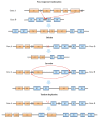Recurrent Fusion Genes in Leukemia: An Attractive Target for Diagnosis and Treatment
- PMID: 29081694
- PMCID: PMC5635644
- DOI: 10.2174/1389202918666170329110349
Recurrent Fusion Genes in Leukemia: An Attractive Target for Diagnosis and Treatment
Abstract
Introduction: Since the first fusion gene was discovered decades ago, a considerable number of fusion genes have been detected in leukemia. The majority of them are generated through chromosomal rearrangement or abnormal transcription. With the development of techniques, high-throughput sequencing method makes it possible to detect fusion genes systematically in multiple human cancers. Owing to their biological significance and tumor-specific expression, some of the fusion genes are attractive diagnostic tools and therapeutic targets. Tyrosine kinase inhibitors (TKI) targeting BCR-ABL1 fusions have been widely used to treat CML. The combination of ATRA and ATO targeting PML-RARA fusions has proven to be effective in acute promyelocytic leukemia (APL). Moreover, therapy with high dose cytarabine (HDAC) has significantly improved the prognosis of core binding factor (CBF) acute myeloid leukemia (AML) patients. Therefore, studies on fusion genes may benefit patients with leukemia by providing more diagnostic markers and therapies in the future.
Conclusion: The presented review focuses on the history of fusion genes, mechanisms of formation, and treatments against specific fusion genes in leukemia.
Keywords: AML; Fusion genes; Leukemia; Recurrent; Target; Treatment.
Figures

References
-
- Nowell P.C. The minute chromosome (Phl) in chronic granulocytic leukemia. Blut. 1962;8:65–66. - PubMed
-
- Rowley J.D. Letter: A new consistent chromosomal abnormality in chronic myelogenous leukaemia identified by quinacrine fluorescence and Giemsa staining. Nature. 1973;243(5405):290–293. - PubMed
-
- de Klein A., van Kessel A.G., Grosveld G., Bartram C.R., Hagemeijer A., Bootsma D., Spurr N.K., Heisterkamp N., Groffen J., Stephenson J.R. A cellular oncogene is translocated to the Philadelphia chromosome in chronic myelocytic leukaemia. Nature. 1982;300(5894):765–767. - PubMed
-
- Shtivelman E., Lifshitz B., Gale R.P., Canaani E. Fused transcript of abl and bcr genes in chronic myelogenous leukaemia. Nature. 1985;315(6020):550–554. - PubMed
-
- a. Dalla-Favera R., Bregni M., Erikson J., Patterson D., Gallo R.C., Croce C.M. Human c-myc onc gene is located on the region of chromosome 8 that is translocated in Burkitt lymphoma cells. Proc. Natl. Acad. Sci. USA. 1982;79(24):7824–7827. - PMC - PubMed
- b. Leder P., Battey J., Lenoir G., Moulding C., Murphy W., Potter H., Stewart T., Taub R. Translocations among antibody genes in human cancer. Science. 1983;222(4625):765–771. - PubMed
- c. Croce C.M., Nowell P.C. Molecular basis of human B cell neoplasia. Blood. 1985;65(1):1–7. - PubMed
Publication types
LinkOut - more resources
Full Text Sources
Other Literature Sources
Miscellaneous
